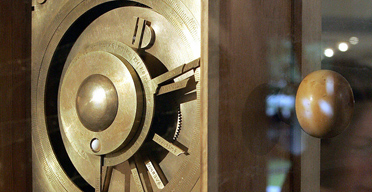Mysteries of computer from 65BC are solved
Ian Sample, science correspondent
· Mechanism hailed as more valuable than Mona Lisa
· Device with gear wheels tracked sun and moon

A reconstruction of the Antikythera mechanism. Photograph: Louisa Gouliamaki/AFP/Getty
A 2,000-year-old mechanical computer salvaged from a Roman shipwreck has astounded scientists who have finally unravelled the secrets of how the sophisticated device works.
The machine was lost among cargo in 65BC when the ship carrying it sank in 42m of water off the coast of the Greek island of Antikythera. By chance, in 1900, a sponge diver called Elias Stadiatos discovered the wreck and recovered statues and other artifacts from the site.
The machine first came to light when an archaeologist working on the recovered objects noticed that a lump of rock had a gear wheel embedded in it. Closer inspection of material brought up from the stricken ship subsequently revealed 80 pieces of gear wheels, dials, clock-like hands and a wooden and bronze casing bearing ancient Greek inscriptions.
Since its discovery, scientists have been trying to reconstruct the device, which is now known to be an astronomical calendar capable of tracking with remarkable precision the position of the sun, several heavenly bodies and the phases of the moon. Experts believe it to be the earliest-known device to use gear wheels and by far the most sophisticated object to be found from the ancient and medieval periods.
Using modern computer x-ray tomography and high resolution surface scanning, a team led by Mike Edmunds and Tony Freeth at Cardiff University peered inside fragments of the crust-encased mechanism and read the faintest inscriptions that once covered the outer casing of the machine. Detailed imaging of the mechanism suggests it dates back to 150-100 BC and had 37 gear wheels enabling it to follow the movements of the moon and the sun through the zodiac, predict eclipses and even recreate the irregular orbit of the moon. The motion, known as the first lunar anomaly, was developed by the astronomer Hipparcus of Rhodes in the 2nd century BC, and he may have been consulted in the machine's construction, the scientists speculate. ...More







No comments:
Post a Comment